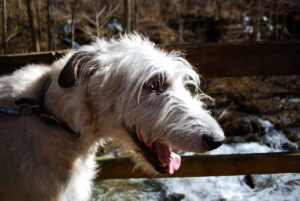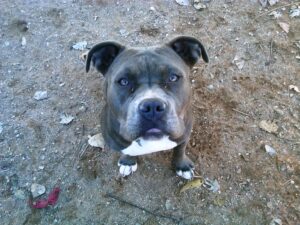Barks Blog
I Have a Dog. What Do I Do Now?

Now and then over the years I’ve tried my hand at painting. Portraits — human and canine — baffled me time and time again. No matter how painstakingly I tried to capture a likeness, the finally product warped. A nose was too long. The eyes weren’t quite right. Or, if I faithfully nailed the lines and proportions, I failed to capture the elusive spark that made the person or dog sitting before me the unique individual they were. The lights were on but nobody was home.
Practice didn’t make perfect, but it certainly helped. The real breakthrough, however, came when I grasped a simple concept: I had to learn to see. It’s a question of focus. When I forgot about that lunch I skipped, pushed past what people said about my last painting, when I quit thinking about the person before me and struggled to make my hand repeat only what my eyes actually saw, the results were… not half bad.
Seeing is learned ability. There’s a gap between our eyes and our brains. Eyes are a magnificent instruments for directing light and color to the brain, but what we “see” is what the brain tells us we see. It interprets. And the brain is full of preconceptions, memories and sometimes ideas that don’t precisely jive with reality. We get in our own way as artists and as photographers, too. Anyone can click a camera button. Few of us are great photographers. We have to learn to see what what’s there and not what our brain tells us we’re seeing. It spells the difference between a Polaroid and an Ansel Adams. One is a blurry snapshot. The other, the light of the moon cascading over the frozen spires of the Tetons and sparkling down the curves the Snake River below.
The art of seeing is a life skill and it applies to dog training as well. I’m thinking of this today as I prepare to drive home from central Florida to Middle Tennessee with Oona, my new Irish wolfhound puppy. For a year now I’ve mapped out the specific training I’ll need to help a giant puppy become a bonded and responsible family companion. My other dogs helped me brush up on my mechanical skills so I’ll know an opportunity to reward when I see one and click and treat with effective timing. Since the litter was born in early July, I’ve gone over photos posted on-line by the breeder like an detective poring over a crime scene. Is my puppy curious? How does she do being held by a visitor? Is she fearful or…was that my puppy bowling over her sibs to get to the food bowl?
From afar, I’ve quizzed people who visited the breeder this summer. How’d the puppies handle startling sounds or thunder? If you squeal, do they let go of your arm with those little shark teeth? I gathered plenty of insights into Oona. But only yesterday did I meet her. Before, I was swimming with impressions of a dog. Then I came nose to whiskery snout with the reality of her. And so the game begins…
It’s a quandary every pet owner faces. I have a dog. What do I do now? How do we even communicate? Dogs are members of another species. They don’t speak the King’s English. But they do speak. Volumes, if you know how to see. There are plenty of on-line tutorials on canine body language covering everything from the various meanings of a tail wags to how dogs hold the corners of their mouths. Turid Rugaas, a noted Norwegian trainer, broke new ground with her writings on calming signals to help you spot signs of stress in your furry friend. They’re all valuable tools to identify and explain behavior, just as operant conditioning and respondent conditioning are essential tools in your kit to modify behavior. But just as in art, there’s still that pesky matter of the brain. So often our preconceptions keep us from seeing the dog in front of us.

We anthropomorphize and decide Fido is feeling guilty because he ate your favorites shoes. He’s not. He’s visibly nervous because he’s afraid the crazy human is about to smack him again with a rolled up newspaper for chewing on that wonderfully aromatic leather he found just lying on the floor. Dogs aren’t little furry people. They have emotions remarkably similar to humans but they have agendas all their very own.
Or, we buy into the teachings of certain television dog trainers and fear that because we let Fifi up on the bed, she’ll get… ideas. Because poodles are descended from wolves and wolves are pack animals. Pack animals go at it tooth and claw to decide who rules. Unless we jerk little Fifi back in line right now, she’ll be running the household by sunup. Bunk. This is dominance theory talking. Fifi just likes being close to you. She’s fine with you being in charge, really.
Or, we think Rover is a practicing clairvoyant because he perks up expectantly when he sees you reach for the leash and he hears keys jangling in your pocket. Relax, Rover is simply observant. He’s been watching you for a very long time. Rover’s not up on the latest theories on human behavior. He just sees what he sees.
To really see Rover, a force-free positive trainer can be your new best friend. Positive training is based on hard research, not pumped up theories. It works with the dog’s actual nature without making the dog fearful. A confident dog doesn’t hide behind conciliatory masks. So there’s likely to be one less barrier between you and your dog.
Also, force-free trainers see a variety of dogs on a daily basis. They make it their business to quickly and accurately size up why Beau lunges at other dogs while on leash or trashes the house when you’re away. They see through the lens of proven science, not iffy theories. Ask your trainer for pointers.
See the dog. Look past canine theories. Stop fidgeting over distractions like whether you’re holding the clicker right or the treat bag is at the best spot for rapid treating. Don’t compare this dog with that. Each dog is a different story, a remarkably unique creation. See the once-wild animal who evolved over tens and thousands of years into man’s perfect best companion. See the runner, the rambler, the high-leaper, the vibrant being who feels what you feel but senses the world altogether differently. Look into his eyes and see who is looking back at you.
See the dog. Then everything begins to fall into place.

